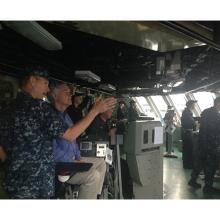
The president released his fiscal year 2017 budget proposal on Tuesday. I will scrutinize its contents - line by line - to ensure that our nation’s treasure is not squandered on wasteful programs or harmful tax hikes. There’s a lot of work ahead, but one area has broad bipartisan support - the size and capability of our Navy fleet. The world is a dangerous place. Make no mistake, my fight will focus on building the most robust, highly-capable fleet.
Over the history of the United States Navy and Marine Corps, our sailors and marines have been asked to perform amazing feats and win astounding victories. From Tripoli to Midway, from Inchon to the Persian Gulf, our forces have protected the nation. The strategy for over 200 years has been to take the fight to the enemy away from our shores with the Navy and Marine Corps as our rapid-response away team.
When it comes to quickly responding to dangerous forces around the world, our Navy must be present closest to where the fight is. To achieve this goal, quantity is a quality of its own. Higher ship counts give us flexibility in tailoring our response to world threats. More ships in more places mean our nation can be more responsive to more threats and helpful to more allies; less ships give us less options and less ability to protect our interests around the globe. A larger fleet also reduces the stress on our ships, sailors and marines who have recently seen deployments lasting ten months or longer.
Having a large fleet is not enough; we must ensure that we maximize the combat effectiveness of each ship. I am encouraged by the Navy’s renewed focus on technologies that will improve ship lethality. I am also encouraged to see progress in advanced rail gun technology, advanced air defense radar, and the progress made in the littoral combat ships’ ability to fight against enemy submarines.

However, we must avoid shortsighted curtailment in ship procurement or early retirement of combat-capable warships. Planning and construction takes longer than most acquisition programs because ships are designed for a 40-year lifetime. Decisions made today can affect the Navy fleet for over 30 years.
Recently, debate has focused on how our naval strategy must choose between building a fleet of smaller, less capable ships to maintaining a worldwide presence versus a larger, more capable fleet to deter and fight great power fleets. The choice between capability and ship numbers is a false one. We must continue to build the number of ships needed to meet our obligations across the globe while developing the technologies that make them the most powerful force in the sea. The world is not getting any safer or any smaller; our national security will continue to demand more ships in the fleet, not fewer.
First elected to Congress in 2000, U.S. Rep. Ander Crenshaw, R-Fla., serves as senior member of the House Appropriations Subcommittee on Defense.


